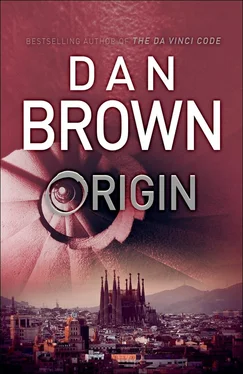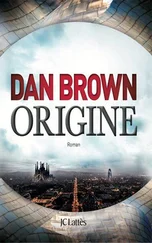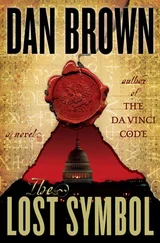Kirsch’s voice grew suddenly quiet and somber. “To permit ignorance is to empower it. To do nothing as our leaders proclaim absurdities is a crime of complacency. As is letting our schools and churches teach outright untruths to our children. The time for action has come. Not until we purge our species of superstitious thinking can we embrace all that our minds have to offer.” He paused and a hush fell over the crowd. “I love humankind. I believe our minds and our species have limitless potential. I believe we are on the brink of an enlightened new era, a world where religion finally departs... and science reigns.”
The crowd erupted with wild applause.
“For heaven’s sake,” Valdespino snapped, shaking his head in disgust. “Turn it off.”
The acolyte obeyed, and the three men drove on in silence.
Thirty miles away, Mónica Martín was standing opposite a breathless Suresh Bhalla, who had just dashed in and handed her a cell phone.
“Long story,” Suresh gasped, “but you need to read this text that Bishop Valdespino received.”
“Hold on.” Martín almost dropped the device. “This is the bishop’s phone?! How the hell did you—”
“Don’t ask. Just read.”
Alarmed, Martín directed her eyes to the phone and began reading the text on its screen. Within seconds, she felt herself blanch. “My God, Bishop Valdespino is...”
“Dangerous,” Suresh said.
“But... this is impossible! Who is this person who texted the bishop?!”
“Shielded number,” Suresh said. “I’m working on identifying it.”
“And why wouldn’t Valdespino delete this message?”
“No idea,” Suresh said flatly. “Careless? Arrogant? I’ll try to undelete any other texts, and also see if I can identify who Valdespino is texting with, but I wanted to give you this news on Valdespino right away; you’ll have to make a statement on it.”
“No, I won’t!” Martín said, still reeling. “The palace is not going public with this information!”
“No, but someone else will very soon.” Suresh quickly explained that the motive for searching Valdespino’s phone had been a direct e-mail tip from monte@iglesia.org — the informant who was feeding news to ConspiracyNet — and if this person acted true to form, the bishop’s text would not remain private for long.
Martín closed her eyes, trying to picture the world’s reaction to incontrovertible proof that a Catholic bishop with very close ties to the king of Spain was directly involved in tonight’s treachery and murder.
“Suresh,” Martín whispered, slowly opening her eyes. “I need you to figure out who this ‘Monte’ informant is. Can you do that for me?”
“I can try.” He did not sound hopeful.
“Thanks.” Martín handed the bishop’s phone back to him and hurried to the door. “And send me a screenshot of that text!”
“Where are you going?” Suresh called.
Mónica Martín did not answer.
La Sagrada Família — the Basílica of the Holy Family — occupies an entire city block in central Barcelona. Despite its massive footprint, the church seems to hover almost weightlessly above the earth, a delicate cluster of airy spires that ascend effortlessly into the Spanish sky.
Intricate and porous, the towers have varying heights, giving the shrine the air of a whimsical sand castle erected by mischievous giants. Once completed, the tallest of the eighteen pinnacles will climb a dizzying and unprecedented 560 feet — higher than the Washington Monument — making Sagrada Família the tallest church in the world, eclipsing the Vatican’s own St. Peter’s Basilica by more than a hundred feet.
The body of the church is sheltered by three massive facades. To the east, the colorful Nativity facade climbs like a hanging garden, sprouting polychrome plants, animals, fruits, and people. In stark contrast, the Passion facade to the west is an austere skeleton of harsh stone, hewn to resemble sinews and bone. To the south, the Glory facade twists upward in a chaotic clutter of demons, idols, sins, and vices, eventually giving way to loftier symbols of ascension, virtue, and paradise.
Completing the perimeter are countless smaller facades, buttresses, and towers, most of them sheathed in a mud-like material, giving the effect that the lower half of the building is either melting or has been extruded from the earth. According to one prominent critic, Sagrada Família’s lower half resembles “a rotting tree trunk from which had sprouted a family of intricate mushroom spires.”
In addition to adorning his church with traditional religious iconography, Gaudí included countless startling features that reflected his reverence for nature — turtles supporting columns, trees sprouting from facades, and even giant stone snails and frogs scaling the outside of the building.
Despite its outlandish exterior, the true surprise of Sagrada Família is glimpsed only after stepping through its doorways. Once inside the main sanctuary, visitors invariably stand slack-jawed as their eyes climb the slanting and twisting tree-trunk columns up two hundred feet to a series of hovering vaults, where psychedelic collages of geometric shapes hover like a crystalline canopy in the tree branches. The creation of a “columned forest,” Gaudí claimed, was to encourage the mind to return to thoughts of the earliest spiritual seekers, for whom the forest had served as God’s cathedral.
Not surprisingly, Gaudí’s colossal Art Nouveau opus is both passionately adored and cynically scorned. Hailed by some as “sensual, spiritual, and organic,” it is derided by others as “vulgar, pretentious, and profane.” Author James Michener described it as “one of the strangest-looking serious buildings in the world,” and Architectural Review called it “Gaudí’s sacred monster.”
If its aesthetics are strange, its finances are even stranger. Funded entirely by private donations, Sagrada Família receives no financial support whatsoever from the Vatican or the world Catholic leadership. Despite periods of near bankruptcy and work stoppages, the church exhibits an almost Darwinian will to survive, having tenaciously endured the death of its architect, a violent civil war, terrorist attacks by Catalan anarchists, and even the drilling of a subway tunnel nearby that threatened to destabilize the very ground on which it sits.
In the face of incredible adversity, Sagrada Família still stands, and continues to grow.
Over the past decade, the church’s fortunes have improved considerably, its coffers supplemented by ticket sales to more than four million visitors a year who pay handsomely to tour the partially completed structure. Now, having announced a target completion date of 2026 — the centenary of Gaudí’s death — Sagrada Família seems to be infused with a fresh vigor, its spires climbing heavenward with a renewed urgency and hope.
Father Joaquim Beña — Sagrada Família’s oldest priest and presiding clergyman — was a jovial eighty-year-old with round glasses on a round face that was always smiling atop his tiny robe-draped body. Beña’s dream was to live long enough to see the completion of this glorious shrine.
Tonight, however, inside his clerical office, Father Beña was not smiling. He had stayed late on church business, but had ended up riveted to his computer, entirely caught up in the disturbing drama unfolding in Bilbao.
Edmond Kirsch was assassinated.
Over the last three months, Beña had forged a delicate and unlikely friendship with Kirsch. The outspoken atheist had stunned Beña by approaching him personally with an offer to make a huge donation to the church. The amount was unprecedented and would have an enormous positive impact.
Читать дальше










